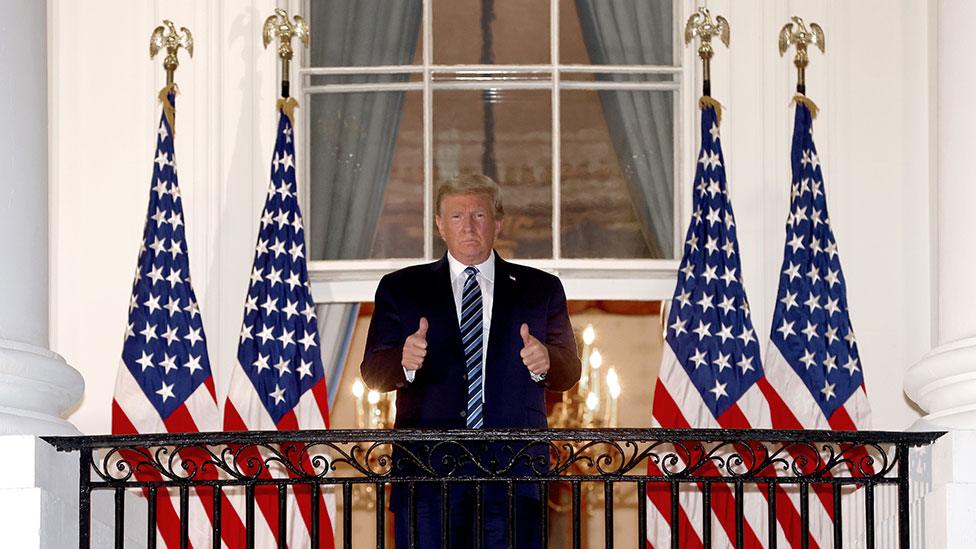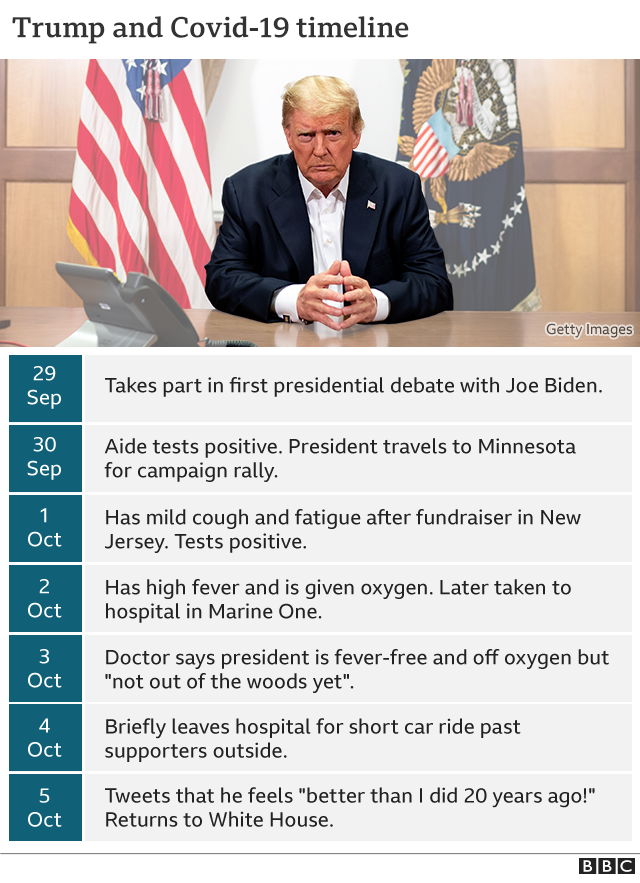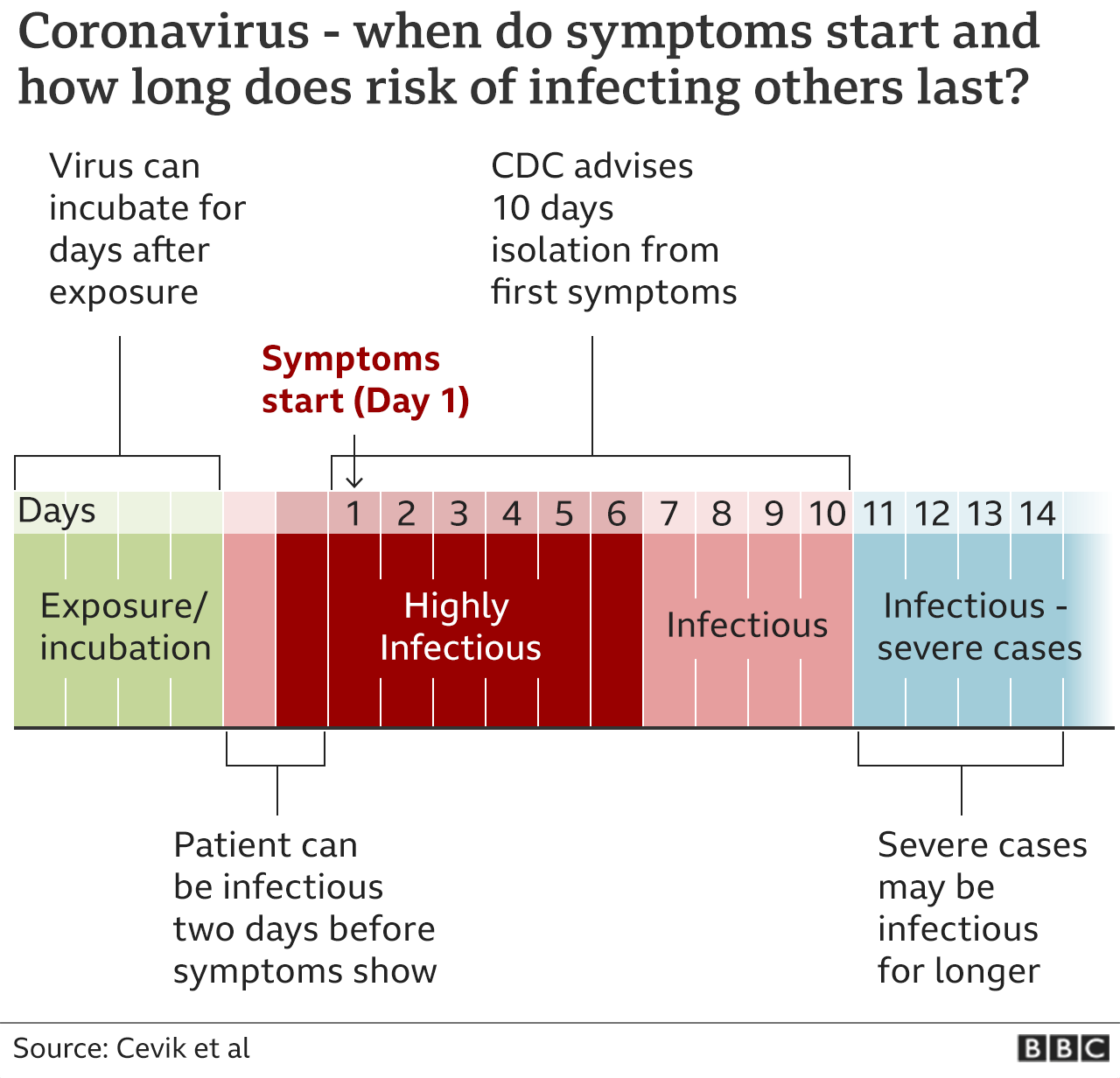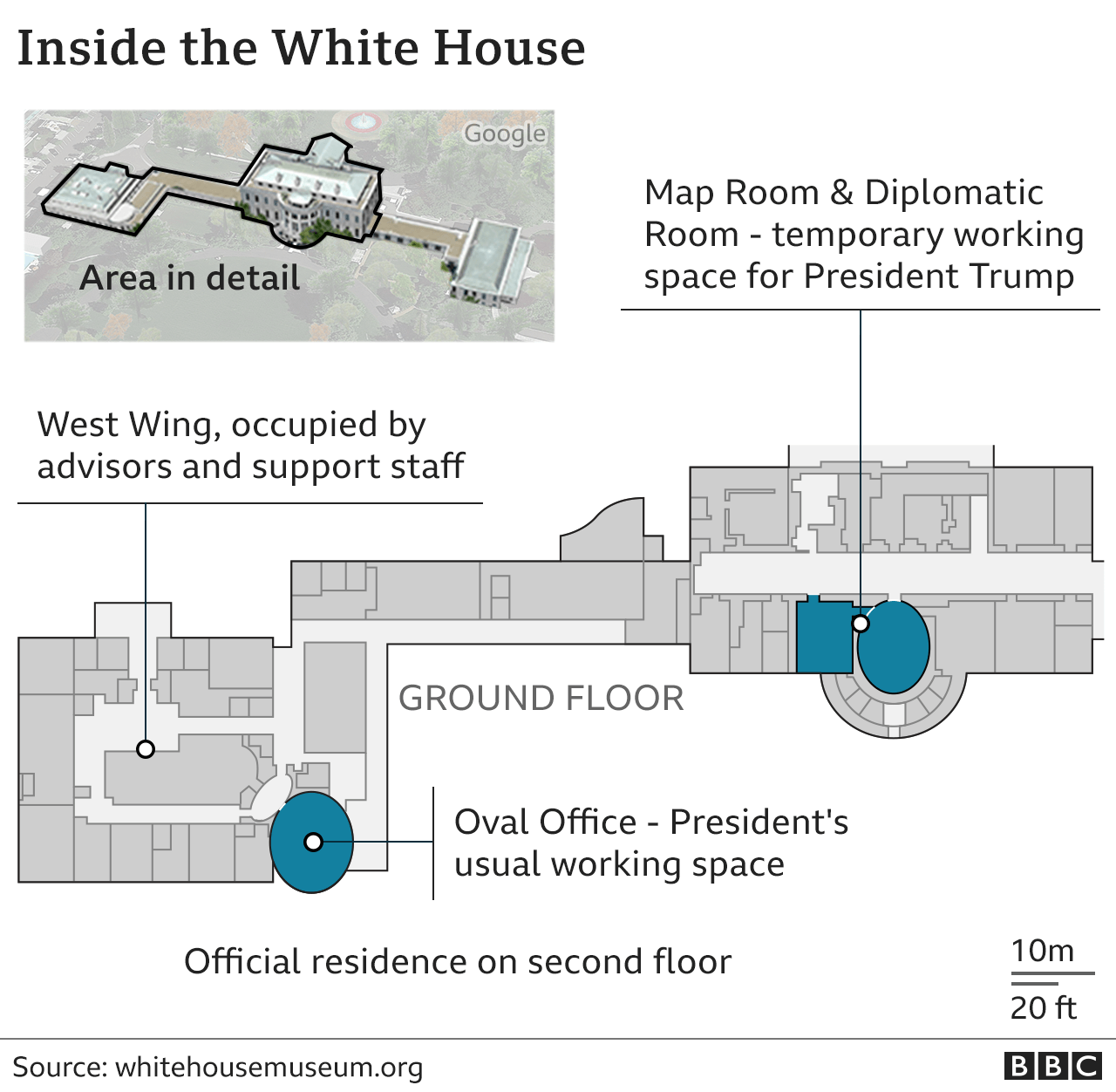Covid: The latest on Trump's health in six graphics
- Published

US President Donald Trump is back at the White House after a dramatic nine days in which he tested positive for coronavirus, was flown to hospital, was given experimental drugs and made an impromptu drive-by to meet supporters while still sick.
How ill has Mr Trump been and has he recovered? These six graphics help explain what we know - and what we don't.

We are not sure when and how Mr Trump caught the virus
In the early hours of the morning of 2 October, Donald Trump tweeted that he had tested positive for Covid-19 the evening before.
As it can take from two to 14 days for symptoms to show after exposure, it is hard to pin down when Mr Trump caught the virus.


Dr Sean Conley, the president's doctor, has refused to say when Mr Trump last tested negative.
This silence has raised questions about whether the president was getting tested every day, or potentially less frequently - in which case he could have been infected earlier than thought.
Adding to the uncertainty was Dr Conley's statement on Saturday 3 October that the president's diagnosis came "72 hours ago" - which would have been on the Wednesday, not the Thursday. The White House later clarified that was a mistake.
But there have also been contradictory briefings about the president's health, with his chief of staff at one point presenting a more downbeat assessment than the doctors, leading to questions about whether he might be further along in his illness than officials say.
All Mr Trump has said is that "somebody got in and people got infected", but gave no more details.

He hosted what might have been a 'superspreader event'
On 26 September, Mr Trump announced his Supreme Court pick, Judge Amy Coney Barrett, in front of a crowd of about 200 people in the White House Rose Garden.
The president and many of the people in his circle who attended the event, have since tested positive, although we don't know for sure where they caught the virus.


They are: Pastor Greg Laurie of Harvest Christian Fellowship in Riverside, California; former New Jersey Governor Chris Christie; the president of the University of Notre Dame, John Jenkins; former White House counsellor Kellyanne Conway; Senator Mike Lee of Utah; Senator Thom Tillis of North Carolina and White House Press Secretary Kayleigh McEnany.
In addition, two other members of the White House press team (not pictured) and photojournalist Al Drago have also tested positive.
Dr Fauci, a member of the White House coronavirus task force, called it a "superspreader event", drawing attention to the fact that people were crowded together and not wearing masks.
Although research into how coronavirus is being transmitted is still being done, a superspreading event is thought to be when one person infects a disproportionately high number of people.

Mr Trump is not the only person at the White House with the virus
A growing group of senior government officials and White House aides have also tested positive for the virus, including First Lady Melania Trump, aide Hope Hicks and a number of Republican senators.
His speechwriter Stephen Miller is the latest aide to test positive - confirming his result on Tuesday.


Press Secretary Kayleigh McEnany and at least three other press staff have also been infected.
The Republican leader in the Senate, Mitch McConnell, 78, said he has not been to the White House since August because of the way it has handled Covid-19, he said.
Although national US guidelines recommend face coverings and 6ft (2m) of separation when outside your household, these rules have not always been observed at the White House. Instead it has relied on rapid tests to screen staff members and visitors for Covid-19.
Large gatherings, like the one held in the White House Rose Garden, are banned in the US capital due to the virus, but federal property like the White House is exempt.

He has taken an unusual mix of drugs
Mr Trump spent three nights - Friday 2 October to Monday 5 October - undergoing treatment at the Walter Reed Medical Center.
His medical team said he had received intravenous antiviral drug Remdisivir, a Regeneron antibody "cocktail" and the steroid Dexamethasone - as well as other more standard supplements and medication. He also received supplemental oxygen.


Dexamethasone, a steroid that calms the immune system, is recommended for use by the World Health Organization in "severe and critical" cases.
Remdesivir is also typically given to patients with severe infection, to cut the duration of symptoms, typically from 15 days down to 11.
His third drug treatment, the antibody therapy known as Regeneron for the company that makes it, is still classed as experimental.
That means the president is one of only a handful of people outside clinical trials to undergo the treatment.
The other medication he has been taking - zinc and vitamin D supplements, famotidine, melatonin and aspirin - are not necessarily related to his diagnosis but their properties and effects are at least well known.

It is not clear when he will stop being contagious
The US Centers for Disease Control and Prevention (CDC) says that for most people "isolation and precautions can generally be discontinued 10 days after symptom onset and resolution of fever for at least 24 hours".
According to doctors, Mr Trump started feeling ill on Thursday and had a fever when admitted to hospital on Friday 2 October.


However the CDC says people with "more severe to critical illness" - which some would say include those needing hospitalisation and supplemental oxygen - are likely to "remain infectious" for up to 20 days after symptoms begin.
The second presidential debate, scheduled for 15 October, was well within this timeframe, although it has now been cancelled.
But speaking to Fox News late on Thursday, Mr Trump said he was feeling "really good" and he held an host an in-person White House event on Saturday.
That was 10 days from when doctors said he began showing symptoms, but only eight days since he passed the CDC requirement of being fever free for 24 hours.
Mr Trump told Fox News he had now stopped taking most "therapeutics" but was still taking steroids and would be tested for Covid-19 again "soon".

Mr Trump says he is back at work
Mr Trump was back at the White House on Monday evening.
His chief of Staff Mark Meadows said new safety measures were in place and that anyone interacting with Mr Trump had been wearing "full PPE, masks, goggles and the like".
A memo on Monday called for limited traffic on the first floor of the West Wing and at the Residence, with strict measures on protective equipment and hand sanitiser for anyone within 6ft (2m) of the president.


- Published8 October 2020

- Published3 November 2020

- Published6 October 2020